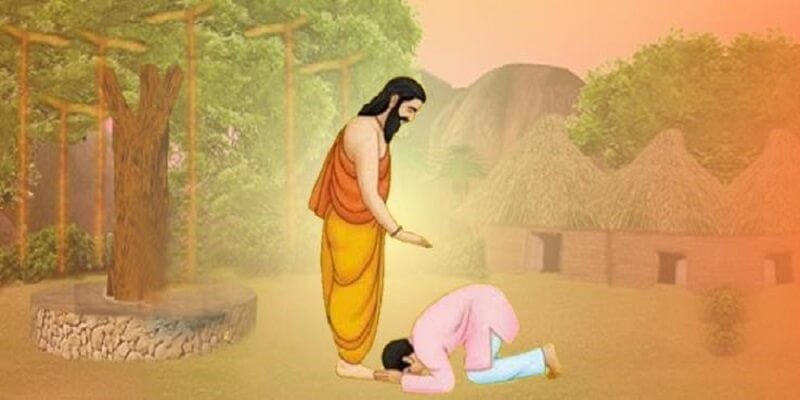Most people in the world have one or two accepted norms of salutation and greeting. However, Hindus have a great variety in this. Conventionally, Indians go in a prostration position at the feet of their parents, elders, teachers, and holy souls and touch their feet. The gesture signifies pranam. In this excerpt, we will discuss the meaning of prostration and it’s significance.
What is the meaning of prostration?
Prostration is when one bows down to touch the feet of any elder. Elders, in turn, bless us by placing their hand on or over our heads. In traditional homes, we do it daily when we meet elders for the first time each day and also on occasions like birthdays, festivals, after performing pujas, and while starting a new venture, to receive their blessings.
Concept of Varishtha Angushtha and Brahma Talu to understand the meaning of Prostration
In the prostration position, while bowing down, one touches one’s elders’ or parents’ feet, more specifically, the Varishtha Angushtha or the big toe of the feet where we find the longest nerve that connects to the Brahma Talu. The aura radiates like a fountain of light from this point of the body. Through the process of Ashirwad, elders, parents, gurus and saints transfer their energy in a mystical manner by touching the Brahma Talu of the one seeking the Ashirwad. The entire process will be well understood if we further analyze the position of prostration.
Unifying the two bodies with cosmic energy in a prostration position
Now that you know the meaning of prostration, let us understand it’s significance. When someone is offering pranam to his guru or parents, he bends down to touch their toes. So they reciprocate by touching his Brahma Talu. Thus creating a cycle of energy that unites the two bodies with cosmic energy. In other words, the energy channelizes from the guru from his blessing hands to the body of the seeker who receives it by touching the guru’s toes. In fact, different ways of spiritual mudras or positions are for saluting gods and spiritual people. Generally, there are six kinds of Prostrations.
Six Kinds of Prostration Position
-
Sashtanga or eight-limb pranaam
The first one of the prostration position is the Sashtanga or eight-limb Pranaam, in which a devout prostrates and eight parts of the seeker’s body touch the ground— knees, stomach, chest, chin, nose, temple, hands and elbows. In this gesture, the devout also swings his head thrice to touch the ground with both his temples and the forehead.
-
Shadanga or six limb pranam
However, the most common type of prostration position is the Shadanga or six limb pranam, in which six parts of the seeker’s body touch the ground—knees, toes, hands, stomach, nose and forehead. This pranam is generally offered to deities in temples.
-
Panchanga or five- limb pranam
There is yet another prostration position is the panchanga or five- limb pranam in which we lower the five portions of the body —toes, knees, hands, nose and forehead. While prostrating, we touch the earth, which is an effective yogic practice that helps us to return to our basic self.
-
Dandavata pranam
The fourth posture is the Dandavata pranam in which a devout merely bows his forehead to the ground and touches the toes of the guru and elders to receive their blessings, which they give by touching his Brahma Talu.
-
Namaskar
The fifth is namaskar, which means namah—I bow to you. Namaskar is touching the forehead with the thumbs of your folded hands thrice. Touching the forehead where the frontal lobe of the brain is placed symbolically means that one is knocking at the eternal vision or the point of the third eye. This is also that part of the body which manipulates the higher mental functions of a person.
-
Abhinandan
The sixth kind of salutation is abhinandan or welcome in which the person gently bends his head forward with folded hands, touching one’s own chest, thereby saying that ‘you reside in my heart’ or ‘you are dear to me’. Air hostesses welcome us aboard planes by the abhinandan greeting.








